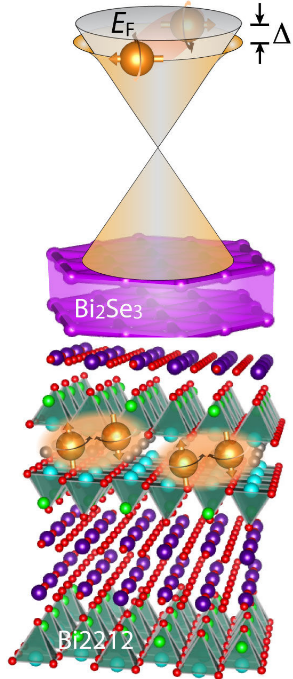Achieving fault-tolerant quantum computing
September 20, 2013

This
schematic of a bismuth selenide/BSCCO cuprate (Bi2212) heterostructure
shows a proximity-induced high-temperature superconducting gap on the
surface states of the bismuth selenide topological insulator (credit:
Berkeley Lab)
But first, we need “fault-tolerant” quantum computers. A small but important step toward this goal has been achieved by an international collaboration of researchers from China’s Tsinghua University and the U.S. Department of Energy (DOE)’s Lawrence Berkeley National Laboratory (Berkeley Lab) working at the Advanced Light Source (ALS).
Using beams of ultraviolet light at the ALS, the collaboration has reported the first demonstration of high-temperature superconductivity in the surface of a topological insulator — a unique class of advanced materials that are electrically insulating on the inside but conducting on the surface.
Inducing high-temperature superconductivity on the surface of a topological insulator (bismuth selenide in this case) opens the door to the creation of a prerequisite for fault-tolerant quantum computing, a mysterious quasiparticle known as the “Majorana zero mode.”
Dealing with decoherence
A big problem with quantum computing is that the quantum data bit or “qubit” used to process and store information is fragile and easily perturbed by electrons and other elements in its surrounding environment. Using topological insulators is considered one promising approach for solving this “decoherence” problem because qubits in a topological quantum computer would be made from Majorana zero modes, which are naturally immune from decoherence.
Information processed and stored in such topological qubits would always be preserved. While the ALS collaboration has not yet identified a Majorana zero mode in their bismuth selenide/BSCCO heterostructures, they believe their material is fertile ground for doing so.
“Our studies reveal a large superconducting pairing gap on the topological surface states of thin films of the bismuth selenide topological insulator when grown on BSCCO,” Fedorov says. “This suggests that Majorana zero modes are likely to exist, bound to magnetic vortices in this material, but we will have to do other types of measurements to find it.”
The high quality bismuth selenide/BSCCO topological thin film heterostructure was made at Tsinghua University in the laboratory of Xi Chen and Qi-Kun Xue using molecular beam epitaxy.
Says Chen, “By controlling the growth kinetics carefully using molecular beam epitaxy, we managed to grow a topological insulator film with controlled thickness on a freshly cleaved BSCCO surface. This provided a cleaner and better-controlled interface, and also opened up opportunities for surface sensitive measurements.”
“Previous work on topological insulators revealed superconductivity at only a few Kelvin with a gap of about one milli-electron volt,” says says Alexei Fedorov, a staff scientist for ALS beamline 12.0.1. “Such a small energy scale and ultra-low temperature makes it particularly challenging to realize Majorana zero modes experimentally, and to distinguish these modes from other states.
“Using ARPES, we show evidence of a superconducting gap persisting in the surfaces of our material up to the transition temperature of BSCCO. As the gap and transition temperature in our heterostructure reflect almost an order of magnitude increase over previous work, we believe ours is a better system to search for Majorana zero modes.”
This research was primarily supported by the National Natural Science Foundation of China.
(¯`*• Global Source and/or more resources at http://goo.gl/zvSV7 │ www.Future-Observatory.blogspot.com and on LinkeIn Group's "Becoming Aware of the Futures" at http://goo.gl/8qKBbK │ @SciCzar │ Point of Contact: www.linkedin.com/in/AndresAgostini
 Washington
Washington